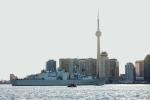Canada - U.S. Relations (Single lesson)
The Mission
Canada - U.S. military agreement: Continuity or change?
In August 2005, the Canadian frigate HMCS Toronto sailed from Halifax to its namesake city, Toronto. The visit was part of a public relations tour of Canadian and American cities along the Great Lakes following the return of HMCS Toronto from the Gulf of Oman where the Canadian ship took part of a mission on the Global War on Terrorism.
The modern navy ship navigated in Canadian waters from Halifax to Toronto. But before HMCS Toronto was allowed to sail to its namesake city, the Canadian Embassy in Washington D.C. had to deliver a formal diplomatic letter to U.S. authorities well before her departure from Halifax.
In your opinion, why would a Canadian navy ship, sailing in Canadian waters, have to send a formal diplomatic note to U.S. authorities before departure?
Investigate the case of the HMCS Toronto based upon the sources provided to you.
1. Explain why Canadian authorities have to notify their U.S. counterparts when Canadian navy ships navigate on the Great Lakes. Use appropriate source(s) and reference(s) to support your explanation.
2. Discuss the implications of such diplomatic procedures for post-September 11 Canada-U.S. relations. More specifically, what has changed since the 1800s in Canada-US relations? What has remained the same?
Steps
1. Consult the satellite map of Eastern Canada and locate relevant information pertaining to the trip of HMCS Toronto from Halifax to Toronto.
2. Search and identify the key characteristics of the Canadian navy ship (tonnage, armament, equipment).
3. Consult and locate relevant documents on Canada-U.S. military treaties.
See evaluations rubrics for specific objectives
To acheive our objective, you need to identify continuity and change. To know more about the concepts of "Continuity and Change" in history, consult The Historical Thinking Project.
